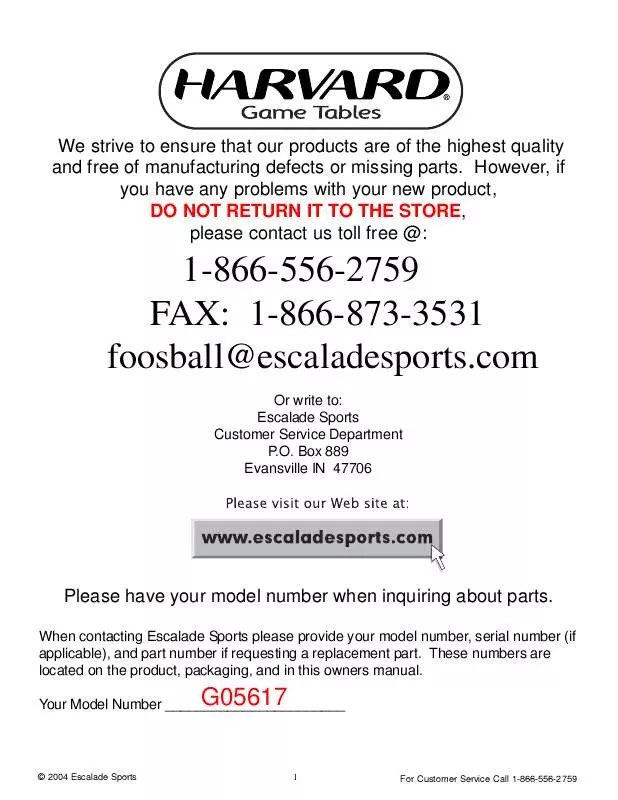User manual ESCALADE SPORTS G05617
Lastmanuals offers a socially driven service of sharing, storing and searching manuals related to use of hardware and software : user guide, owner's manual, quick start guide, technical datasheets... DON'T FORGET : ALWAYS READ THE USER GUIDE BEFORE BUYING !!!
If this document matches the user guide, instructions manual or user manual, feature sets, schematics you are looking for, download it now. Lastmanuals provides you a fast and easy access to the user manual ESCALADE SPORTS G05617. We hope that this ESCALADE SPORTS G05617 user guide will be useful to you.
Lastmanuals help download the user guide ESCALADE SPORTS G05617.
Manual abstract: user guide ESCALADE SPORTS G05617
Detailed instructions for use are in the User's Guide.
[. . . ] We strive to ensure that our products are of the highest quality and free of manufacturing defects or missing parts. However, if you have any problems with your new product, DO NOT RETURN IT TO THE STORE, please contact us toll free @:
1-866-556-2759 FAX: 1-866-873-3531 foosball@escaladesports. com
Or write to: Escalade Sports Customer Service Department P. O. Box 889 Evansville IN 47706
Please have your model number when inquiring about parts.
When contacting Escalade Sports please provide your model number, serial number (if applicable), and part number if requesting a replacement part. These numbers are located on the product, packaging, and in this owners manual. [. . . ] Alternately, the players make a move, starting with the white player (the player that plays with the white pieces. ) A move consists of moving one of the pieces of the player to a different square, following the rules of movement for that piece - there is one special exception, named castling, where players move two pieces simultaneously. A player can take a piece of the opponent by moving one of his own pieces to the square that contains a piece of the opponent. The opponents piece then is removed from the board, and out of play for the rest of the game. (Taking is not compulsory. ) At the start of the game, the position of the pieces is as follows. Thus, at the second row, there are eight white pawns, at the seventh row, there are eight black pawns. At the first row, from left to right, we have a: rook, knight, bishop, queen, king, bishop, knight, and rook. Note that the queens start of squares of their own color, with a dark square in each players left hand corner. Movement of the pieces Rook The rook moves in a straight line, horizontally or vertically. The rook may not jump over other pieces, that is: all squares between the square where the rook starts its move and where the rook ends its move must be empty. (As for all pieces, when the square where the rook ends his move contains a piece of the opponent, then this piece is taken. The square where the rook ends his move may not contain a piece of the player owning this rook. ) Bishop The bishop moves in a straight diagonal line. The bishop may also not jump over other pieces.
© 2004 Escalade Sports
23
For Customer Service Call 1-866-556-2759
Queen The queen has the combined moves of the rook and the bishop, i. e. , the queen may move in any straight line, horizontal, vertical, or diagonal. Knight The knight makes a move that consists of first one step in a horizontal or vertical direction, and then one step diagonally in an outward direction. The knight jumps: it is allowed that the first square that the knight passes over is occupied by an arbitrary piece. For instance, white can start the game by moving his knight from b1 to c3. The piece that is jumped over is further not affected by the knight: as usual, a knight takes a piece of the opponent by moving to the square that contains that piece. Pawn The pawn moves differently regarding whether it moves to an empty square or whether it takes a piece of the opponent. When a pawn does not take, it moves one square straight forward. When this pawn has not moved at all, i. e. , the pawn is still at the second row (from the owning players view), the pawn may make a double step straight forward. For instance, a white pawn on d2 can be moved to d4. When taking, the pawn goes one square diagonally forward. There is one special rule, called taking en-passant. [. . . ] It is marked by an (x) in the small square in the upper right-hand corner of the frame where it was made. The count for one strike is 10 plus the number of pins knocked down on the player's next two deliveries. Triple or Turkey - Rule 4 Three successive strikes is a triple or turkey. To bowl the maximum score of 300, the player must bowl 12 strikes in succession. [. . . ]
DISCLAIMER TO DOWNLOAD THE USER GUIDE ESCALADE SPORTS G05617 Lastmanuals offers a socially driven service of sharing, storing and searching manuals related to use of hardware and software : user guide, owner's manual, quick start guide, technical datasheets...manual ESCALADE SPORTS G05617


